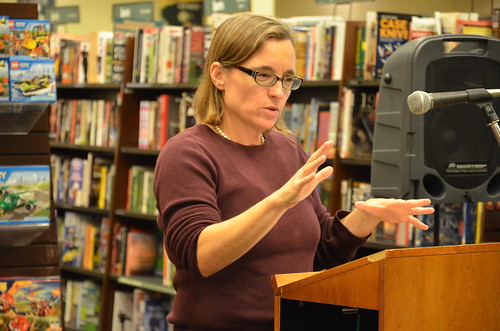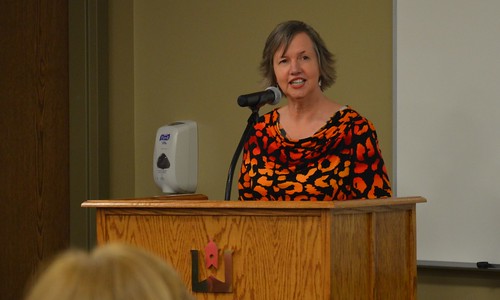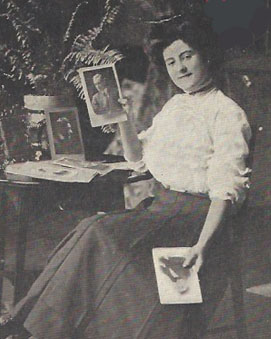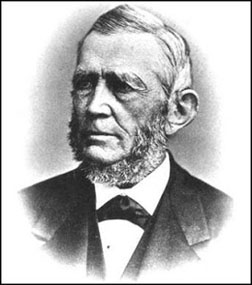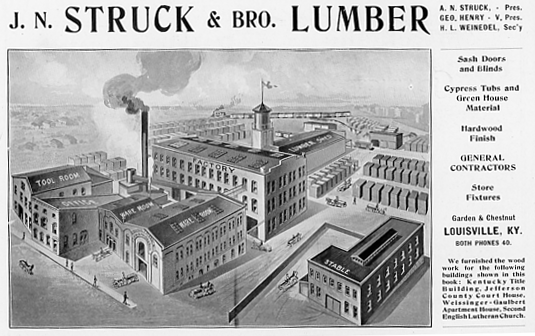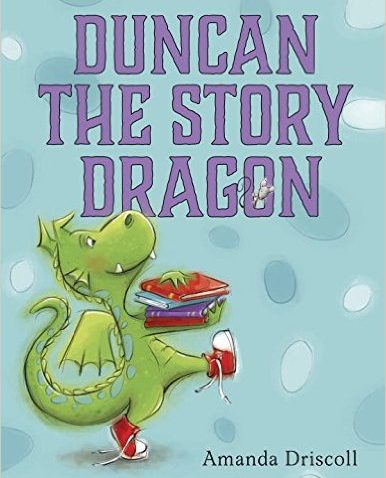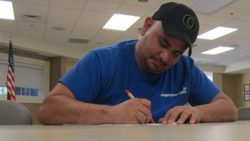Christine Ehrick, Associate Professor of History at the University Louisville, talked about “Radio and the Gendered Soundscape: Women and Broadcasting in Argentina and Uruguay, 1930-1950” on the evening of Thursday, October 20, 2016 at Barnes & Noble (1680 Campbell Lane).
Far Away Places presents Christine Ehrick and “Radio and the Gendered Soundscape: Women and Broadcasting in Argentina and Uruguay, 1930-1950”
Comments Off on Far Away Places presents Christine Ehrick and “Radio and the Gendered Soundscape: Women and Broadcasting in Argentina and Uruguay, 1930-1950”
Filed under Uncategorized
Kentucky Library Associate Professor Nancy Talks on Her New Book about a Kentucky Guitarist
Nancy Richey, Associate Professor of WKU Libraries’ Department of Library Special Collections, spoke at WKU’s Owensboro Regional Campus on the evening of Monday, October 17, 2016 on her new book Mose Rager: Kentucky’s Incomparable Guitarist, which she had coauthored with the late retired WKU history professor Carlton Jackson. Mose Rager was a guitarist famed for his unique thumbing style.
Comments Off on Kentucky Library Associate Professor Nancy Talks on Her New Book about a Kentucky Guitarist
Filed under Uncategorized
The “Comforts” of Home
October 31, 1934 marked the closing of the second and final season of Chicago’s A Century of Progress International Exposition, also known as the Chicago World’s Fair. In Bowling Green, Kentucky, the Times-Journal newspaper had arranged three-day tours for local residents, with discounted railroad and hotel rates, admission tickets, and local sightseeing trips. The total cost per person was a mere $18.45–about $350 today, but still a bargain.
The 38 million people who attended the Fair found a spectacular attraction, but when so much humanity converged on one place, there was bound to be a darker side–accidents, illnesses and even deaths. Indeed, an outbreak of dysentery, traced to contaminated drinking water at a local hotel, sickened more than 1,700 and killed almost 100 tourists.
On Sheridan Road, however, the Coombs-McCready Funeral Home was alert to the possibility of an uptick in what was, after all, their business, and sought to assure funeral directors across the country of its willingness to act as liaison in the event that a member of their community did not survive the Fair.
“It is more comforting to a bereaved family to feel they are dealing direct with you, whom they know, and not with a stranger,” wrote the firm’s president to Bowling Green’s Gerard Funeral Home. Accordingly, for $40, “we will represent you and adhere strictly to your instructions”–from intake to providing a casket (another $40) to transferring the remains to the train station for the journey home. Gerard’s funeral director was invited to forward contact information to Chicago “which will simplify matters at the time we are called to serve you”–and allow those who had suffered loss to connect with home for the necessary rituals.
The Coombs-McCready Funeral Home letter is part of the Gerard Family Collection in the Manuscripts & Folklife Archives section of WKU’s Department of Library Special Collections. Click here to access a finding aid. For other collections of funeral home records and information about the Gerard family, search TopSCHOLAR and KenCat.
Comments Off on The “Comforts” of Home
Filed under Manuscripts & Folklife Archives
“In Reply to Your Ad”
In the internet age, those looking for matrimony have many venues in which to market their charms, but at the turn of the 20th century, answering a personal ad in a newspaper or magazine was the principal way to cast a wide net into the sea of eligible bachelors and spinsters.
In January 1907, 21-year-old Lillie Rasdall of Bowling Green, Kentucky replied to 28-year-old Seldon Mantz’s ad for a suitable companion to share his home in Webster, Iowa. Predictably, her letter touched on those traits that might interest her correspondent. “I am very tall weight 125 have Blue eyes fair complexion and dark hair,” she wrote. She had moved from the country to Bowling Green three years previously, but hinted that city life had not spoiled her. “I am a Kentucky girl can do [any] kind of house work.”
A few years later, 52-year-old “John” replied from his Missouri home to Lucy Boucher of Settle, Kentucky. After reading her ad, he had concluded that “you are all I should be looking for.” Like Lillie Rasdall, he inventoried the qualities he thought might interest his 50-something correspondent. A five-foot-ten-inch widower with salt-and-pepper hair, no children, a moderate lover of tobacco but not of strong drink, he described his pleasant home, which needed only “a good loving wife” to complete it. He did “not want a cent of the money my future wife shall have” but at the same time seemed interested in an honest accounting of what he would forgo: “I do not want one that will misrepresent anything.”
In each case, the letter-writers then broached the next step in the encounter: the exchange of photographs. You go first, they both seemed to say, then I will send you mine. Perhaps there was follow-up, but these exchanges did not succeed in lighting the flame of matrimony. Lillie, sadly, died the following year, Seldon was still a bachelor at 61, and Lucy remained single all her life.
These letters are part of the Manuscripts & Folklife Archives collections of WKU’s Department of Library Special Collections. Click on the links to access finding aids. For more courtship letters from generations of Kentuckians, search TopSCHOLAR and KenCat.
Comments Off on “In Reply to Your Ad”
Filed under Manuscripts & Folklife Archives
Serafina and the Black Cloak bestselling author Robert Beatty to visit BG
Bestselling author Robert Beatty will visit Bowling Green on Thursday, October 20 at 6pm at the Warren County Public Library’s Bob Kirby Branch as part of the annual SOKY Reads one book, one community reading program. 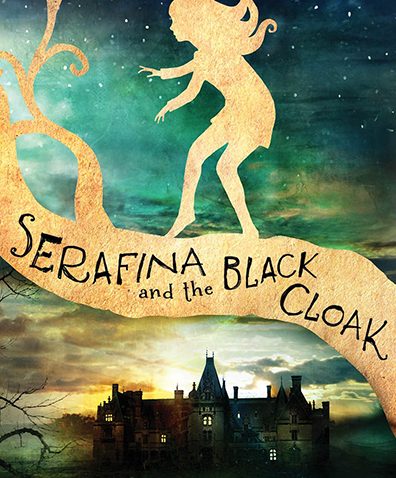 Beatty will read from and sign both Serafina and the sequel, Serafina and the Twisted Staff. This event is free and open to the public. Books will be available for purchase on site.
Beatty will read from and sign both Serafina and the sequel, Serafina and the Twisted Staff. This event is free and open to the public. Books will be available for purchase on site.
Serafina and the Black Cloak, part one in a three-part series, is a mystery-thriller published by Disney Hyperion. The book is set at the Biltmore Estate in Asheville, North Carolina and features the energetic, intelligent heroine Serafina as she solves the mystery of the sinister Man in the Black Cloak. A compelling mix of historical fiction, excellent characterization, and high-energy adventure, the book has excited audiences since its release and more than 25 weeks on the NYT bestseller list. It won the Pat Conroy Southern Book Prize and received outstanding reviews from Kirkus, Publishers Weekly, and more. 300 copies of the book were distributed to schools throughout Bowling Green, thanks to the generous sponsorship of Graves Gilbert Clinic. Funding from Friends of the Warren County Public Library provided more than 100 additional books given away during various community events during September. As part of his visit to Kentucky, Beatty will also speak at local schools in the area as well.
SOKY Reads is an outreach program of the Southern Kentucky Book Fest, a partnership of the Warren County Public Library, Barnes and Noble Booksellers, and WKU Libraries. To learn more about getting involved in the SOKY Reads program next year, contact Sara Volpi, Literary Outreach Coordinator for WKU Libraries, at sara.volpi@wku.edu.
Comments Off on Serafina and the Black Cloak bestselling author Robert Beatty to visit BG
Filed under Uncategorized
Oil and Spirits
Similar to the practice of dowsing or water witching–the use of an implement such as an L-shaped rod or a Y-shaped tree branch to divine the location of underground water sources–is “doodlebugging,” which uses the same mysterious technology to locate petroleum or mineral deposits. In September 1894, John G. Jackson, a New Jersey surveyor, railroad engineer, astronomer and former state senator, was confident that this supernatural aid would vindicate his as-yet unsuccessful search for oil in Kentucky.
Writing to a stockholder in his struggling company, Jackson reported that “various Psychic influences” had urged him not to give up. Previous drilling efforts had come close, but fate had not been with him: “We have been told by mediums experienced in Petroleum oil matters,” he explained, “that we missed the location of the first well, through mischievous spirit influences, but a short distance.” Now, however, “different mediums many miles asunder have united in pointing out the places wherein success will be certain.” All that was needed was courage, perseverance–and yes, a new infusion of cash for the project. “If the sanguine promises of the psychics prove genuine,” Jackson assured his correspondent, “that will yield very handsomely.”
John G. Jackson’s letter is part of the Manuscripts & Folklife Archives collections of WKU’s Department of Library Special Collections. Click here for a finding aid. For other collections about petroleum exploration in Kentucky, search TopSCHOLAR and KenCat.
Comments Off on Oil and Spirits
Filed under Manuscripts & Folklife Archives
Catalogue of Short Horn Bulls, Cows and Heifers
A recent and rare acquisition for the Department for Library Special Collections, with only 16 pages total, is a Catalog of Short Horn Bulls, Cows and Heifers (1864) that offers 12 bulls and 48 cows for sale by William & Benjamin Warfield of Lexington, KY. The Warfields, as observed in the Cyclopedia of American Agriculture must be included in any history of Shorthorns. They were prominent and quite well known during the years in which Kentucky supplied much of the Shorthorn blood to the breeding herds of this famous breed throughout the United States. William was the son of Benjamin Warfield and also a breeder of the shorthorn cattle in Kentucky. William Warfield was one of the best informed men on Shorthorn history and Shorthorn pedigrees. He contributed much to live stock and especially to Shorthorn literature, writing the “History of Improved Shorthorn Cattle” and “The Theory and Practice of Cattle Breeding.” The Warfield’s most active period was during the 1870s and 1880s, when the farmers of Kentucky, Ohio, and westward began extensively to improve their stock by the use of purebred cattle.
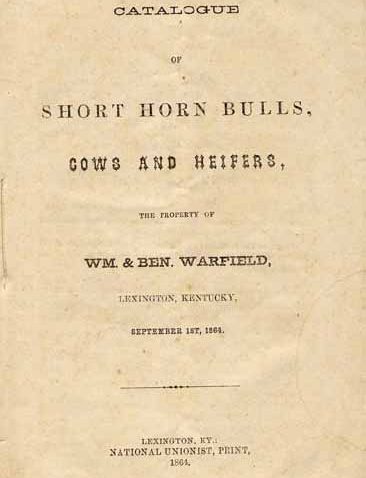
Short-horn cattle were developed in England to serve as both dairy and beef animals and were brought to America in 1783. Exciting auctions of livestock were common in the 1800s and catalogues such as this one, were produced. This catalog offered details of the animals such as color, date calved and lineage for each with an example being: “Young Duke, the sire of a number of animals in this catalogue, was bred by R.A. Alexander, was by Duke of Airdrie (12730) out of imp. Rosabille, by Bridegroom (11203) &c.” The Kentucky Encyclopedia notes that many of the prize winning shorthorns of the era enjoyed as much prestige as some of the governors and perhaps contributed as much or more to the national recognition of the commonwealth! The Kentucky Library Research Collection is the only known repository of this catalog. To see other books and illustrative materials in Special Collections search our catalog, KenCat or WKU Library One Search.
Comments Off on Catalogue of Short Horn Bulls, Cows and Heifers
Filed under New Stuff
Library Adds Rare Architecture Book to Collection
Recently the Department for Library Special Collections purchased a rare promotional book produced by the Louisville architectural firm of Kenneth McDonald and J.F. Sheblessy. Kenneth McDonald worked as an architect in the Falls City for a number of decades. He graduated with a civil engineering degree from Virginia Military Institute in 1873. While teaching, he worked for the architectural firm ran by his brother, Harry Peake McDonald. In 1878 the two brothers joined forces under the firm name H.P. McDonald and Brother. When they were joined by two of their other brothers, the firm became McDonald Brothers and enjoyed an enviable practice with commissions from around Kentucky and several contiguous states. The building type for which the firm was most noted was the fortress-like jails built across the Commonwealth. The old Simpson County Jail (now the Simpson County Archives) is the closest extant example of a McDonald Brothers’ jail. They eventually designed over 100 jails in seven states. The main building for the Southern Exposition in Louisville is perhaps their best known design, but one that remains a favorite is the old Presbyterian Theological Seminary (today Jefferson County Community College) which can be viewed from the raised Interstate 65 as one passes through downtown Louisville. In their wisdom, McDonald & Dodd selected Bowling Green limestone as the building material for that Gothic campus.
Kenneth McDonald left the firm in 1895 and practiced solo for several years before forming the practice with John F. Sheblessy in 1901. This practice lasted less than five years, for in 1906 McDonald joined with architect William J. Dodd, a partnership that lasted until 1913, when McDonald moved to San Francisco. Sheblessy (1873-1938) moved on to Cincinnati and enjoyed a long architectural career. The brevity of the McDonald and Shelbessy partnership makes this promotional book quite rare. Printing companies that specialized in this specific genre of architectural firm “advertising” were not uncommon, but this book was printed by the Courier-Journal Job Printing Company, again making it a rarity.
This book, containing both photographs and drawings, highlights some of the practice’s most important projects, including several churches–most notably Walnut Street Baptist Church, courthouses, residences, commercial buildings, and sprawling government structures such as the East Tennessee Insane Asylum. The booklet also includes twenty-five pages of ads for regional contractors, building supply operators, lumber companies, fixture suppliers, etc. One contractor of note is Peter & Burghard Stone Company whose name is mentioned in captions alongside a number of the photographs as providing the cut stone work for the highlighted projects. Peter & Burghard was known across the south for their tombstones and their other stonework. When Van Meter Hall was built at WKU in 1911, Louisville architect Brinton B. Davis insisted on employing Peter & Burghard as the stone contractor. According to WorldCat, WKU’s Library Special Collections is the only repository to hold this illustrated promotional piece. To see other architectural treatises, drawings, and plan books in Special Collections search our catalog, KenCat.
Comments Off on Library Adds Rare Architecture Book to Collection
Filed under Acquisitions, Uncategorized
Driscoll wins the 10th annual Evelyn Thurman Young Readers Book Award
Western Kentucky University Libraries has selected Duncan the Story Dragon, written and illustrated by Amanda Driscoll, as the winner of the tenth Evelyn Thurman Young Readers Book Award. The national award was created to honor the memory of former WKU librarian Evelyn Thurman, who made significant contributions to children’s librarianship and literacy during her 25 years of service to the university and community. Books eligible for the award must be written or illustrated by a Kentucky author or illustrator or have a significant Kentucky-related connection.
This year’s winning book is a children’s illustrated book. Duncan, the main character, is a charming fire-breathing dragon who loves to read. According to Driscoll’s website, his imagination catches fire, but so does his book.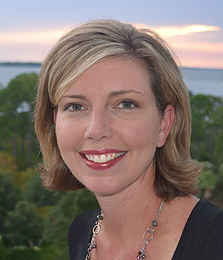
Kirkus Reviews said “…vivid colors, expressive faces, and comic details make this one likely to be a storytime hit. Like the last sip of a chocolate milkshake, it’s very satisfying.”
“Readers will enjoy the sweet story and whimsical illustrations as Duncan the Story Dragon finally figures out the ending to his story,” said Renee Hale, selection committee member and school media librarian at Drakes Creek Middle School.
Amanda Driscoll was born and raised in Louisville, Kentucky. She worked as a graphic designer in the corporate marketing departments of Humana and Providian, and directed art at a Louisville ad agency. She has been with her own company, Driscoll Creative, since 1997. After having children, Driscoll rediscovered her love of picture books, finding her true passion. Duncan the Story Dragon was her debut picture book, released in June 2015.
The author will be honored at an awards luncheon in November. While in the area, Driscoll will visit local schools, reinforcing the importance of reading, writing and the value of books. Visit http://www.wku.edu/library/awards/evelynthurman.php for more information about the award.
This program is made possible by the Evelyn Thurman Children’s Author Fund, the Southern Kentucky Book Fest partnership, and Friends of WKU Libraries. For more information, contact Sara Volpi, literary outreach coordinator for WKU Libraries, sara.volpi@wku.edu or 270-745-4502.
Comments Off on Driscoll wins the 10th annual Evelyn Thurman Young Readers Book Award
Filed under Events, Latest News, New Stuff

